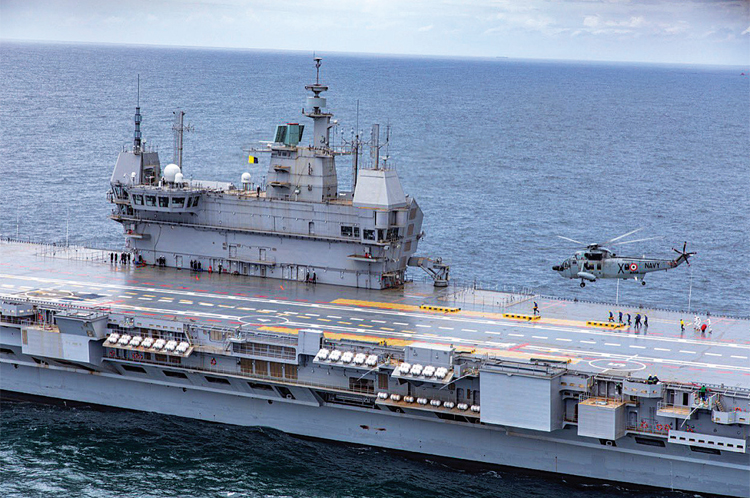INDIAN ARMED FORCES CHIEFS ON OUR RELENTLESS AND FOCUSED PUBLISHING EFFORTS

The insightful articles, inspiring narrations and analytical perspectives presented by the Editorial Team, establish an alluring connect with the reader. My compliments and best wishes to SP Guide Publications.

"Over the past 60 years, the growth of SP Guide Publications has mirrored the rising stature of Indian Navy. Its well-researched and informative magazines on Defence and Aerospace sector have served to shape an educated opinion of our military personnel, policy makers and the public alike. I wish SP's Publication team continued success, fair winds and following seas in all future endeavour!"

Since, its inception in 1964, SP Guide Publications has consistently demonstrated commitment to high-quality journalism in the aerospace and defence sectors, earning a well-deserved reputation as Asia's largest media house in this domain. I wish SP Guide Publications continued success in its pursuit of excellence.
- MoD initiates comprehensive review of Defence Acquisition Procedure 2020, pushes for defence reforms
- G7: The Swansong
- Kalinga Connect: South Asia to Polynesia
- Advanced MRSAM for India for a greater firepower
- Must Credit DRDO for Operation Sindoor, now what is next for defence R&D?
- Operation Sindoor | Day 2 DGMOs Briefing
- Operation Sindoor: Resolute yet Restrained
LEAD STORY
Indian Navy’s Aircraft Carrier Goal and Programme
The question we need to ask is this: Do we want to be a regional power and have the capability to be counted in the Indian Ocean and the larger Indo-Pacific? If yes, then we need to invest in maritime capability and a potent Navy. There is a need for air power at sea and it is here and now.

 | The author is former Chief of the Naval Staff (CNS) of Indian Navy. During his tenure as the CNS, he also served as Chairman of the Chiefs of Staff Committee. He retired on May 31, 2019. The Admiral is currently the Chairman of National Maritime Foundation. |
India’s Role in Indo-Pacific
It is widely acknowledged that the fortunes of a nation are determined, to a great extent, by its geography. Looking at India’s geography, we can only rejoice at our good fortune. India’s central position in the IOR, astride the important sealanes of the world, gives us immense strategic advantages. It facilitates reach, sustenance and mobility of our maritime forces, thereby giving us an ability to effectively influence this maritime space. While this geography affords us opportunities to harness the seas to our advantage, it has also placed us at the very centre of the ongoing ‘Strategic churn’ taking place in this region. Its impact on India in the future will be determined by our outlook and choices that we adopt today. There is little dispute over the fact that the Indo-Pacific today is characterised by multi-layered and multi-faceted diversity. India has been growing/rising steadily in an interconnected world which is depended on the oceans. The world today is a maritime centric world and India’s future is fundamentally linked to the Indian Ocean. It will be at our peril if we neglect the maritime domain. There is a need for India to play a greater role in geostrategic affairs, if we are to be counted as a regional power. To play this role, the nation needs to invest in maritime capability in all its dimensions.
Navy’s Tryst with Aircraft Carriers
The successful completion of the maiden sea trials of the Indigenous Aircraft Carrier Vikrant in the first week of August 2021, was a red letter day for the Nation and the Navy. The Indian Navy Aircraft Carrier saga goes back to 1961 with the commissioning of INS Vikrant a CATOBAR (Catapult-Assisted Take–Off but Arrested Recovery) Light Carrier flying the Sea Hawks and Alize aircrafts. She underwent a modernisation in late 1980’s to a STOVL (Short Take off, Vertical Landing) carrier on induction of the Sea Harrier aircrafts. In 1986 the Navy inducted INS Viraat, and for a decade, the Navy had two aircraft carriers in the fleet till the decommissioning of INS Vikrant in January 1997.

The Navy took up a case for replacement for INS Vikrant in Mid 90’s. The actual work on the present Vikrant started in 1997 with the Naval Design Team visiting INS Viraat to understand the intricacies of an aircraft carrier, this being the first time the Team had been tasked with designing a carrier. In 1999 the project was authorised for development and construction. It started off as an Air Defence Ship (ADS) of about 30,000 tonnes in STOBAR (Short Take-off But Arrested Recovery) configuration. The project received formal government sanction in 2003. The designation was changed to Indigenous Aircraft Carrier (IAC) displacing about 45,000 tonnes designed to operate the MiG-29K fighter aircraft.
The IAC-2 can be funded by Navy’s share of the budget if its share goes back to 18 per cent with no effect on other programmes as the expenditure for the IAC-2 will be spread over a period of about 10 years
The initial sanction was for 2,300 crore, which included investment in infrastructure at Cochin Shipyard to construct the IAC, which the Navy was to get back with the actual cost once the design was frozen. The revised sanction was for 19,000 crore which was finally hiked to 23,000 crore.
Indigenous Aircraft Carrier – IAC-1
The Project can lay claim to a number of firsts. IAC is the most complex shipbuilding project ever undertaken in India. Designed by the Navy’s own Design Bureau with consultancies from across the world, it has been built by Cochin Shipyard Limited (CSL) who had no past experience of building a warship. It has put India in a small league of nations that have designed and built aircraft carriers. The IAC project led to the development of indigenous marine grade steel which was first used in her construction and now the DMR 249 steel developed is being used for all naval ship construction in the country. A number of other sub systems and machinery have also been developed in the country. The entire electrical cabling running to some 3,000 km has been supplied by Indian companies. The ability to design, construct and fit out has been demonstrated. There have been delays in the execution of the project. The initial construction was delayed in view of the decision to build her with indigenous steel and now there have been delays due to failure of timely supply of the Aviation Facilities Complex from Russia and a few other equipment. Vikrant will now be put through her paces with a series of sea trials and with the Navy’s recent experience of commissioning INS Vikramaditya, it should be smooth sailing.
IAC-2 – A Prerequisite
The Navy’s Aircraft Carrier acquisition has always faced head winds. The Nation went into a similar debate in the 90s when the IAC-1 case was put forward, as what is happening now in the case of the IAC-2. The IAF then also went into an overdrive of laying similar claims of their ability to provide air defence and strike at sea. In the past thirty years, this ability to provide air defence not been demonstrated. Even strike at sea is limited in range to the ROA of the aircraft. The issues raised against aircraft carriers are, cost, vulnerability to modern missiles, the need for expeditionary capability, sea control vs sea denial, submarine vs aircraft carrier etc., to name a few.
There is no doubt that an aircraft carrier and its air wing cost a large sum. The Navy’s share of the defence budget was 18 per cent in 2012, it is close to 14 per cent now, the IAC-2 can be funded by Navy’s share of the budget if its share goes back to 18 per cent with no effect on other programmes as the expenditure for the IAC-2 will be spread over a period of about 10 years.
We need to get out of the continental mind set and look at the maritime domain for that is where we enjoy an advantage due to our geographic location
All platforms, whether on land, air or sea have vulnerability: aircraft to air defence systems and tanks to anti-tank missiles. The majority of analysis has been done by viewing the Carrier as operating in isolation, which is not the case. The aircraft carrier is part of a composite group of ships called the Carrier Battle Group, which has inbuilt offensive and defensive capability against surface, subsurface and air threats. Similarly, we have a composite group of armour, mechanised infantry and other support arms on land and a composite strike package for the air. The vulnerability of an aircraft carrier, in my opinion, is overblown. The case of aircraft carrier vs submarine cannot be placed in an either/or format. The submarine, whether conventional or nuclear powered, in whatever number, cannot replace the capabilities and the geostrategic efforts a CBG brings to bear in the maritime domain. The mobility, reach, combat power and also the visibility in peace time a CBG provides at sea cannot be done by submarines. The submarine plays a very different role in the maritime domain and order of battle.
Conclusion
The question we need to ask is this: Do we want to be a regional power and have the capability to be counted in the Indian Ocean and the larger Indo-Pacific? If yes, then we need to invest in maritime capability and a potent Navy. The geostrategic challenges in the Indian Ocean are only going to increase in the coming decade. There is a need for air power at sea and it is here and now, and it would be at our peril if we as a nation do not invest in maritime capability. Challenges on our land frontier will remain what they are, but we need to get out of the continental mindset and look at the maritime domain, for that is where we enjoy an advantage due to our geographic location and the capability which the Indian Navy brings to bear.





